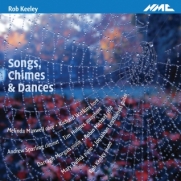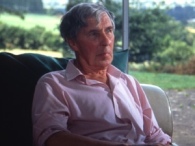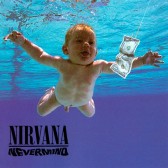The omni-present cultural blogger, Miscriant, has been wielding a sharpened pencil again, and reviews Led Bib’s recent gig as part of this year’s Sounds New festival.
Read it online here.
The omni-present cultural blogger, Miscriant, has been wielding a sharpened pencil again, and reviews Led Bib’s recent gig as part of this year’s Sounds New festival.
Read it online here.
The sun-drenched opening clarion call of ‘Music for Art and Tom’ sets the scene for the whole of Songs, Chimes and Dances, a survey of chamber music written between 1994 and 2007 by British composer Rob Keeley.
The opening piece displays Keeley’s trademark lyrical melodic writing in the saxophone’s woven lines, punctuated by prismatic chordal textures in the piano. Moving in step, the two instruments chime together in the second, more sedate section, with some beautifully struck sonorities in the accompaniment. There’s a charm to the music – but this isn’t to damn it; instead it’s a robust charm, one that is assured, supported by a good bone-structure – less simplistic than it is solid in its evolving form and musical language, a characteristic that runs throughout Keeley’s music.
 There’s a questing sense to the opening widely-spaced sonority of the second piece on this disc, ‘Bells of Halkis,’ a question posed that the rest of the piece endeavours to answer in the ensuing, gradually unfurling lines. In contrast, the following ‘Little Trio’ moves with a bustling character in its combination of clarinet, cello and piano.
There’s a questing sense to the opening widely-spaced sonority of the second piece on this disc, ‘Bells of Halkis,’ a question posed that the rest of the piece endeavours to answer in the ensuing, gradually unfurling lines. In contrast, the following ‘Little Trio’ moves with a bustling character in its combination of clarinet, cello and piano.
The two-movement ‘Two Ways of Looking At A Spider’ is reminiscent of that other, great work for classical guitar, Tippett’s Blue Guitar. Filigree textures contrast with vibrant struck chords and plucked harmonics in the opening ‘A Spider Dances,’ followed by the contrasting, evocative nocturne, ‘The Spider Laments at Night’. The piece is here exquisitely performed by guitarist Jonathan Learwood.
The opening of the Andante of the ‘Trio for Horn, Violin and Piano’ employs a falling gesture enriched with the timbre of the French horn, a languorous figure which slowly draws out its colours as it repeats. A dancing scherzo pitches the piano against deftly-stepping violin and horn duo; the final movement (subtitled ‘Piccola Scena Amorosa’) explores a darker hue, drawing on the rich ochre colour of the French horn at the heart of the ensemble.
The suite which gives the disc its name is a series of six studies; lithe, agile, lyrical, Puckish, including the warm hues of no.V, or the minimalist-style exploration of a fixed set of pitches gradually evolving in no. VI. This is music under a clear sky, open, lyrical and inventive, effortlessly played by oboist Melinda Maxwell
 The last suite, ‘Oregon Moods,’ for clarinet, alto saxophone and piano opens with a beautiful series of chords, a gestures which, in typical fashion, repeats and evolves as it explores its own potential. There’s an hommage to the quixotic Erik Satie in the lyrical yet sad third movement, ‘Gallic.’
The last suite, ‘Oregon Moods,’ for clarinet, alto saxophone and piano opens with a beautiful series of chords, a gestures which, in typical fashion, repeats and evolves as it explores its own potential. There’s an hommage to the quixotic Erik Satie in the lyrical yet sad third movement, ‘Gallic.’
I first heard Keeley’s music in the lithe On The Tiles (2003) for violin and piano, the brisk, energetic Concerto for Piano and Twelve Instruments (2007) and the lissom Six Inventions for Flute and Clarinet written in 2011. What struck me immediately was the vigour, the energy combined with an assured ear for textural detail and a radiant harmonic language, which this music imparted. The music on the current disc is from an earlier period, and whilst the later chamber works display a tonal language that becomes less openly Mediterranean, perhaps, in its tonal palette, Keeley’s harmonic language remains clear, full of colour; at once immediately accessible yet rich in its tonal colours. There’s a Ravelian quality to the piano writing, with occasional reminiscences of George Benjamin; there’s mischief too, alongside the sonorous landscape evoked by pieces such as Bells of Halkis. Keeley’s formal organisation seems to rely less on traditional methods than on evolving patterns, hinted ostinati that evolve, or question-and-answer exchanges between instruments, musical lines engaged in dialogue, and through-composed, singing melodies possessed of a resourceful inventiveness. Keeley writes great endings to his pieces, too; either darting, scurrying lines that conclude abruptly, inconclusively, or sonorities that are left deliberately poised, waiting to pursue harmonic avenues left unexplored; as a listener, you are left wanting more.
This disc is released on the NMC label, which in 2013 celebrated its twenty-fifth year, an age belied by the youthful vigour of its catalogue; the survey on this album shines a light through the stained-glass hues of some of Keeley’s chamber music.
Over on Inquire, editor Matthew Gilley pens an insightful review of Robert Stillman’s Leap of Death project, part of Sounds New 2014 that took place earlier this week.
Read it online here.
The ubiquitous culture-blogger, Miscriant, has been at it again; here’s a terrific review of the Icebreaker concert at the festival last week, featuring Brian Eno’s beautiful response to the NASA moon-landings footage, Apollo: for All Mankind, a premiere by Ed Bennett, and pieces by Julia Wolfe and Roy Carrol. Plus some lovely photographs. as usual.
Read the review online here.
Terrific review of the launch night of Sounds New 2014 from culture-vulture and Kent-based blogger, Miscriant, which includes some very fine photographs of the Piano in the a Woods exhibition and Janek Schaefer’s sound-installation at the Sidney Cooper Gallery.
 Read for yourself online here.
Read for yourself online here.
Kent’s cultural blogger, The Demon Gin, has been on the prowl recently, and has written fiercely about the forthcoming festival. Read it online here; be warned (if you’re reading this in a public place), it will make you laugh out loud… With thanks to TDG!
Tippett’s second opera, King Priam, comes to the Marlowe Theatre on Wednesday 23 April, and should be required viewing both for fans of this much-eclipsed composer, as well as for operatic admirers.
 The opera, like its composer, has been overshadowed by that bastion of the English compositional Establishment, Benjamim Britten; Priam was premiered in Coventry Cathedral in 1962, the day before Britten’s War Requiem. But perhaps because Tippett was never quite embraced by the establishment in the same way as Britten was, his music is equally not as self-consciously bombastic, as mannered, as Britten’s; there’s a refreshingly instinctive honesty, a vibrant can’t-help-myself quality to Tippett’s music (for all the impenetrability of later works: the Knot Garden, anyone ?). The joyous Second String Quartet, the Concerto for Double String Orchestra, positively bound off the page in their exuberant, wild and positive energy.
The opera, like its composer, has been overshadowed by that bastion of the English compositional Establishment, Benjamim Britten; Priam was premiered in Coventry Cathedral in 1962, the day before Britten’s War Requiem. But perhaps because Tippett was never quite embraced by the establishment in the same way as Britten was, his music is equally not as self-consciously bombastic, as mannered, as Britten’s; there’s a refreshingly instinctive honesty, a vibrant can’t-help-myself quality to Tippett’s music (for all the impenetrability of later works: the Knot Garden, anyone ?). The joyous Second String Quartet, the Concerto for Double String Orchestra, positively bound off the page in their exuberant, wild and positive energy.
In writing Priam, Tippett wanted to portray a timeless concept that would make his choice of subject matter, drawn from Greek tragedy, resonate in twentieth-century post-war Britain: as Tippett himself declared it, “the absolute solitude of the tragic characters under the gaze of the hidden God.” The drama explores human relationships, the wider considerations of the dilemma of choice and the ultimate truth that perhaps we cannot fully grasp the intricate web of ramifications of the choices we make. The solitude of the characters stems from their inability to see the complete web of implications woven by their decisions, which of course leads inexorably to Priam’s eventual death.
Tippett’s instrumental tapestry for the opera is always inventive, breaking up the homogeneity of the orchestra and including the use of piano and classical guitar, the latter especially effective in the aria ‘Oh, rich-soiled land’ sung by Achilles (and later distilled into the suite ‘Songs for Achilles;’)
English Touring Opera brings King Priam to Canterbury; it promises to be an unmissable experience. In a fit of giddy excitement, I bought my tickets weeks ago: make sure you get yours…
Saxophonist / composer Robert Stillman is bringing a lost Murnau film back to life next month, as part of Sounds New. I talked with Robert about the project, the challenges of bringing a lost film back to life, and the influence of the mischievous Erik Satie.
DH: What inspired you to come up with this project ?
RS: I first learned about the lost ‘4 Devils’ film through a very good documentary about it made by Janet Bergstrom that was an extra on the Sunrise DVD. I was intrigued by this idea of that a film can just disappear completely; it seemed so exotic in our age of obsessive preservation-added to the fact that it was this dark, weird tale of orphans sold to the circus to be trained up into a trapeze act. So I thought it would be interesting to somehow use this missing artefact as the starting point for a new one.
 DH: Thinking of the highly Expressionist style of Murnau’s ‘Nosferatu’ in particular, how are you able to conjure up or realise the visual element of the missing film as part of the performance ?
DH: Thinking of the highly Expressionist style of Murnau’s ‘Nosferatu’ in particular, how are you able to conjure up or realise the visual element of the missing film as part of the performance ?
RS: ‘Leap of Death’ is being released as a limited edition of 50 bookwork/vinyl LPs, and we’re going to be projecting images from the bookwork during the performance. The printmaker/writer Anna Fewster composed these images as ‘imaginary fragments’ of the ‘4 Devils’ narrative, and they are inspired in part by what we know about the look of ‘4 Devils’ film (from remaining archive materials), but also by photos and posters from circuses of this time, and this era of film in general.
DH: Is the fact that you’ve written a score to a film that’s missing an aspect of the performance itself, ie. should listeners be trying to re-create the film for themselves ?
RS: That’s the idea- we wanted to create an impression or feeling of the lost film, but some listeners might imagine something even more literal and structured in terms of narrative. The music is based around themes that relate loosely to characters, ideas, and in some cases scenes, and these are referenced in the titles and images we’re projecting, but these are really just little seeds for people’s imaginations.
DH: Tell me about these multi-media aspects of the performance: what can audiences expect to experience ?
RS: We’ll perform the score with a 6-piece band (organ, trumpet, saxophone, trombone, tuba, drums), alongside continuous projection of images and text from the ‘Leap of Death’ bookwork. The idea is to create a ‘live’ version of the bookwork/LP.
DH: The dance-band style music of the 1920’s has a distinct character – is your music a homage to, or a recreation of, the music of the period ?

Robert Stillman
RS: I wasn’t focusing too heavily on trying to recreate or pay tribute a style per se, though I guess I had the sound of Hollywood film composers like Steiner, Newman, and even Chaplin in mind- I really like that hybrid musical language they used that combines the chromaticism of contemporary European classical with American popular music influence. For this piece I was going for music that was complex and rich but that was essentially built on hummable tunes- and with plenty of woodblock!
DH: Do I detect perhaps hints of Satie about the music, his Parade in particular ? Was Satie an influence ?
RS: Satie’s the man, and definitely an influence for me. My first idea for ‘Leap of Death’ was actually a Diaghilev-vibe contemporary ballet, so the Parade idea makes sense. I’d still love to realise it this way some day – it would work well with the 4 Devils’ trapeze acts.
With thanks to Robert for his time. Find out more about Leap of Death at Sounds New next month online here.
There’s a question percolating on Twitter this morning in connection with a talk to be given by Andrew Burke, Chief Executive of the London Sinfonietta, as part of an event organised by The People’s Salon next month:
Is contemporary music just aping some of the promotion and presentation tricks of the visual arts or are we more willing to take risks as contemporary music audiences?
Now, aside from the loaded terminology being used here – ‘aping’ and ‘just’ being burdened with negative connotations – the question itself presumes that particular aspects of advertising and presenting events are the sole prerogative of particular art-forms. This can be tricky territory; pigeon-holing the language of advertising serves only to perpetuate its clichés.
I realise, of course, than the language of advertising needs to be tempered specifically to its target audience: the tone of promoting a Saga Holiday for the over-50’s is rather different to that used to sell high-energy drinks to athletes. And not everything works across different art-forms. The giant fibreglass statues of Michael Jackson, one of which was floated down the River Thames in 1995 to promote the HIStory tour, might not be right for a new recording by John Eliot Gardiner;

Funky dollar bill…
That iconic baby-chasing-a-dollar-bill image on the cover of Nirvana’s Nevermind might not work to sell the next Dudamel disc (although if anyone uses the idea, you read it here first…). And in the current economic climate, it might be seen as excessively profligate to repeat The KLF’s stunt in 1994 of burning a million dollars. There are many pages on Andy Doe’s marvellous blog, Proper Discord, devoted to classical album covers that don’t work.
But that doesn’t mean that only pop culture has the right to use these methods. And the idea of classical concerts needing to be enshrined in concert-halls before devoted admirers is now obsolete. Festivals and organisations are looking elsewhere. To give but two examples: last year, the London Contemporary Music Festival enthralled audiences (according to the festival website, over 5,000 people) in a car-park in Peckham, embracing a vibrantly eclectic mix of events, including contemporary and electronic music, dance and improvisation and serving up works by Xenakis and Ligeti. The Park Avenue Armory in New York saw over seventy musicians filling the former drill hall with John Luther Adams’ Inuksuit as part of the Tune-In Festival in 2011.
All this is to say that what we really need is wider thinking beyond a sense that you can only deploy certain marketing for certain art-forms, and particular types of events can only take place in specific venues. Innovation is key: thinking of ways to engage audiences with culture shouldn’t see us rattling around in the same wooden boxes, limited to well-trodden campaigns that are deemed appropriate only because their use is enshrined in advertising history. Andy Warhol saw through that back in the 60s; so can we.
Dan Harding is Deputy Director of Music at the University of Kent. Follow Dan on Twitter.
There’s a veritable feast of contemporary music in store in July at this year’s Cheltenham Music Festival.
 There’s a concert from the Choir of Royal Holloway and Dame Felicity Lott in a prgramme that will include Britten, Poulenc, Michael Berkeley, Anthony Pitts and a new piece by Gabriel Jackson.
There’s a concert from the Choir of Royal Holloway and Dame Felicity Lott in a prgramme that will include Britten, Poulenc, Michael Berkeley, Anthony Pitts and a new piece by Gabriel Jackson.
The Choir of Trinity College, Cambridge bring a programme of Britten, Pärt, John Tavener and Howells, amongst other pieces.
The City of London Sinfonia perform Britten, Michael Zev Gordon, and Tippett‘s vivacious Concerto for Double String Orchestra.

Credit: Festival website
Brothers Colin and David Matthews are featured in a concert from the Schubert Ensemble, whilst the Birmingham Contemporary Music Group première The Lighthouse Keepers by David Sawer alongside the Feldman/Beckett Words and Music (Sawer appears In Conversation before the concert).
The music of Dai Fujikura features alongside music by Britten, Poulenc and Stravinsky‘s Rite of Spring in a two-piano concert extravaganza as well.
Lots to look forward too; lots of success to the Cheltenham Music Festival in July!